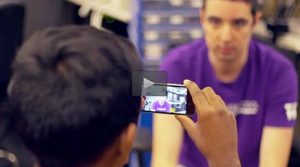Pupilscreen; an app to diagnose concussion

A concussion is one of the fields where a number of researchers around the world are working on for better assessment, diagnosis, prevention, and treatment. Often athletes lose their lives or end up living a life with various degrees of disability due to poor assessment, miss diagnosis, delayed presentation, or not having specialist person, knowledge or equipment required to perform an adequate assessment of concussion on site immediately.
Also, the best screening tools or protocols available so far for this life-threatening condition are all subjective. The players who really want to get back to the game for various reasons tend to find different ways to get back to the game by providing false information. But it may not be a case anymore now. Recently, researchers from the University of Washington have developed a smartphone-based app named PUPIL SCREEN, which can be a game changer for on the field assessment of concussion as it provides an objective data. The app works by analyzing a person’s Pupillary Light Reflex, and initial reports about the app are promising.
“Having an objective measure that a coach or parent or anyone on the sidelines of a game could use to screen for concussion would truly be a game-changer,” says Shwetak Patel, the Washington Research Foundation Endowed Professor of Computer Science & Engineering and of Electrical Engineering at the UW, in a media release.
“PupilScreen aims to fill that gap by giving us the first capability to measure an objective biomarker of concussion in the field,” says co-author Dr. Lynn McGrath, a resident physician in UW Medicine’s Department of Neurological Surgery.
“After further testing, we think this device will empower everyone from Little League coaches to NFL doctors to emergency department physicians to rapidly detect and triage head injury.”
While the UW team initially tested PupilScreen with a 3D printed box to control the eye’s exposure to light, researchers are now training their machine learning neural network to produce similar results with the smartphone camera alone, the release notes.
“The vision we’re shooting for is having someone simply hold the phone up and use the flash. We want every parent, coach, caregiver or EMT who is concerned about a brain injury to be able to use it on the spot without needing extra hardware,” shares lead author Alex Mariakakis, a doctoral student in the Paul G. Allen School of Computer Science & Engineering, in the release.
“Instead of designing an algorithm to solve the specific problem of measuring pupil response, we moved this to a machine learning approach—collecting a lot of data and writing an algorithm that allowed the computer to learn for itself,” adds co-author Jacob Baudin, a UW medical student and doctoral student in physiology and biophysics.